Thermal protective varnish application technique
Preparatory stage
Before applying a fire retardant varnish, the composition should be thoroughly stirred until a homogeneous mass is formed. If necessary, the paint and varnish material can be filtered. When working with a thick composition, it can be slightly diluted with water. However, the proportion of water in the solution should not exceed 3%.
Next, you need to carefully prepare the surface before applying thermal protective varnish to it. The surface should be completely cleaned of dust and dirt particles. If there are oil and bitumen stains on the coating, they must be removed. In addition, heat-resistant paint and varnish material on a frozen wood surface is strongly discouraged. Also, the varnish should not be mixed with paints or solvents.
If natural ventilation does not provide proper air exchange, then it is better to connect forced ventilation. When working with heat-resistant varnish, it is necessary to wear rubber gloves, as well as goggles and a respirator to protect the eyes and respiratory organs.
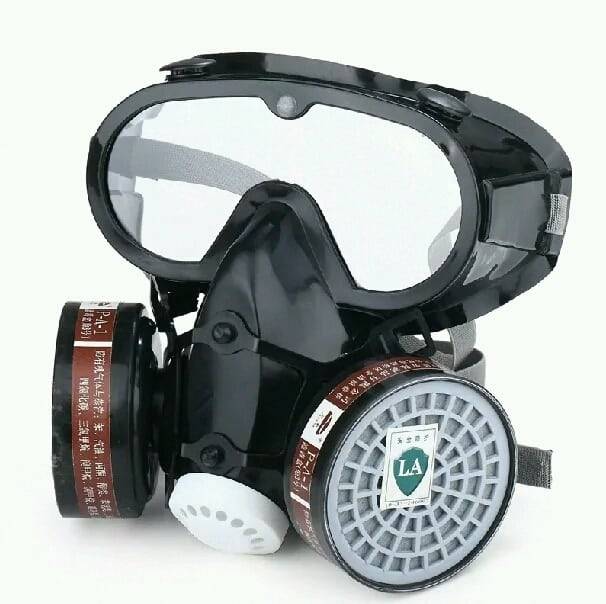
Varnish application stage
It is recommended to apply heat-resistant wood varnish only to those surfaces that are not exposed to water or mechanical damage. Otherwise, the paintwork can be removed or destroyed, which will lead to a decrease in its protective and aesthetic properties.
Refractory paint can be applied with a brush, roller or spray. Although this is a colorless varnish, you should avoid smudges, streaks or bubbles when working with a brush or roller. By working with a pneumatic sprayer, you can avoid these problems. In this case, the paintwork will look like a fog.
The thermal protective compound should be applied in two directions perpendicular to each other. Thanks to this crossing, it is possible to achieve an even coverage of the entire area as a whole. In order to achieve uniform color when applying in parallel stripes, it is necessary to ensure that the jet of the pneumatic spray passes from one strip to another.
In particular, such a surface is not completely covered at once, but only a small part of it. To do this, apply a thin layer to a certain area and make sure that the varnish does not spoil the coating and is distributed evenly. If everything suits you, then you just need to wait until this area is completely dry and then process the rest of the area.
When applying a clear, fire-resistant varnish, the first coat should be allowed to dry for at least 8 hours. As for the rest of the layers, they will generally dry for about 5 hours. In this case, the ambient temperature should not be less than +20 degrees. If you want to obtain a sufficient level of fire protection corresponding to the 1st group, it is best to cover the surface in 3 or 4 coats.
In general, a heat-resistant paint and varnish material provides reliable protection of any surfaces from fire and exposure to high temperatures. When applied correctly, this coating will not only provide the surface with resistance to fire, but also give it a more aesthetic appearance.
This is interesting: Smokehouse from a gas cylinder
Views
According to their composition, varnishes for bricks are divided into four types:
- polymer;
- solvent;
- acrylic;
- fireplace (or stove).
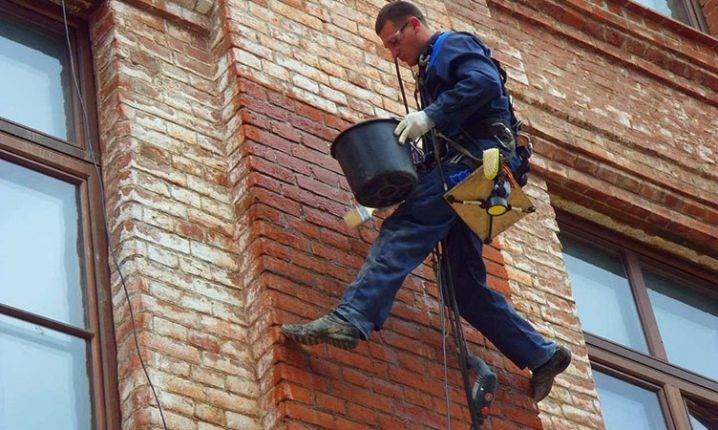
Polymeric varnishes are based on alkyd resins and acrylic polymers, as well as organic and inorganic additives. Each additive affects the enhancement of certain properties and characteristics. Some affect wear resistance, others - on resistance to aggressive environments.
In solvent-based varnishes, silicone resins are used as the basis. Such paintwork materials penetrate deep into the body of building materials, create an elastic coating. The transparent layer does not crack, and the presentable appearance of the masonry remains throughout the entire service life.
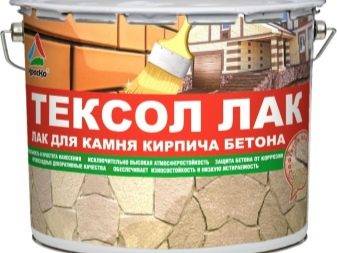
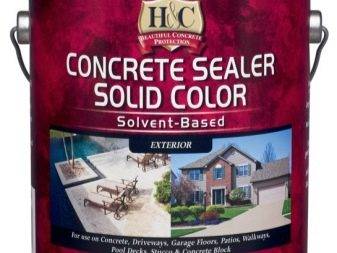
Acrylic varnishes have a multicomponent composition and are intended for interior use. Acrylic mixtures are made on organic solvents, which protect against the formation of efflorescence, prevent the formation of cracks and other mechanical damage.
Fireplace paints and varnishes can be characterized as heat-resistant, fire-resistant and heat-resistant. The varnish prevents condensation. It is used for decorative coating of fireplaces and stoves, suitable for facade cladding.
On request, it is possible to obtain a matt or glossy finish with a specific gloss quality. Special additives make it possible to treat the plane in such a way that a "wet effect" is formed. Paints and varnishes are produced in cans or buckets of various sizes, and as an aerosol in cans.
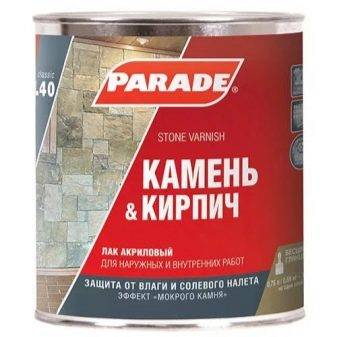
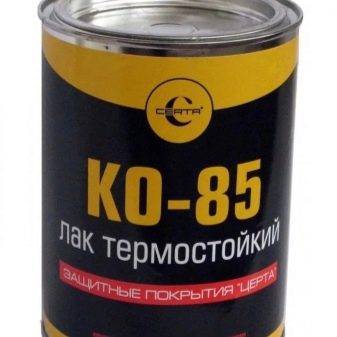
Heat-resistant varnish for stoves and fireplaces as fire protection
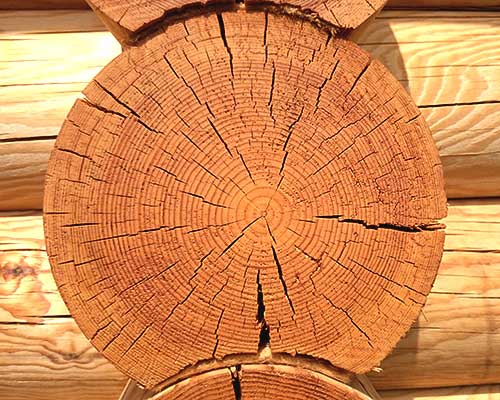
Heat-resistant varnish for stoves and fireplaces is used for refractory treatment of brick or stone surfaces of furnaces and chimneys of stoves and fireplaces in order to preserve the integrity of their structure when exposed to high temperatures.
The use of refractory varnish for stoves in steam rooms and saunas or the treatment with heat-resistant varnish for fireplaces in cottages and on barbecue sites allows not only to extend the life of brick, stone and iron structural elements, but also to preserve their original aesthetic appearance.
It should be borne in mind that heat-resistant varnish is not an ordinary fire-retardant paint, which is often not suitable for its technical characteristics and at the same time can greatly change the appearance of the natural masonry of a fireplace or stove.
Under no circumstances should conventional fire protection agents be used instead of a special heat-resistant varnish, since heated parts of the elements of stoves and fireplaces treated with such flame retardants can also ignite due to exposure to high temperatures.
Thus, the question of whether one should select and buy a specialized heat-resistant varnish for ovens for such processing or try to save money and use something else will be more rhetorical.
Where in Moscow to buy high-quality heat-resistant varnish for the oven
Obviously, for the refractory treatment of a furnace insert or chimney, it is necessary to use special ready-made varnishes for fireplaces and stoves, which can be bought either on the construction markets, or in companies dealing with fire protection and fire retardant materials.
We invite you to familiarize yourself with the heat-resistant varnish for stoves and fireplaces KO-85, which is made by a Russian production company located in Chuvashia. This refractory varnish is today the recognized leader in sales on the construction market in Russia among all other varnishes for fireplaces and stoves.
It is cheaper and more convenient to buy this composition in Moscow by ordering it in the quantity you need from our company, since the price of heat-resistant varnish for stoves and fireplaces KO-85 is similar to the selling price from the manufacturer.
Why are the ovens varnished
During operation, the stone or brick, from which the stove or fireplace is laid, eventually lose its thermal resistance, may begin to crack and crack, which can violate the structural integrity of both the firebox itself and the air duct.
In addition, dust, dirt and soot quickly accumulate on the surface of stoves or fireplaces that are not treated with heat-resistant varnish, which are difficult to clean and spoil the original appearance of these structures.
And if we are talking about stoves-heaters in steam rooms and saunas, then a constant drop in humidity in the brick or masonry is additionally added, as well as the effect of a large amount of moisture on the inter-seam joints of the masonry of the firebox or facing of such furnaces.
To prevent all these harmful effects and to protect the stove or fireplace from further destruction, the outer and inner surfaces of these structures are treated with special heat-resistant varnishes.
What materials are suitable for
Modern heat-resistant varnishes are quite suitable for working with the following materials:
- brick (this can be fireclay refractory, decorative or standard brick);
- stone (both natural and artificial);
- ceramics;
- plaster;
- metal (such as cast iron or steel alloy);
- wood.
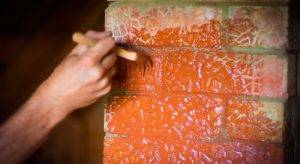 It is worth saying in more detail about the choice of a heat-resistant composition for wooden surfaces, especially since some stoves and fireplaces may have elements of wooden decor. Special care must be taken here, as wood ignites very quickly without proper protection.
It is worth saying in more detail about the choice of a heat-resistant composition for wooden surfaces, especially since some stoves and fireplaces may have elements of wooden decor. Special care must be taken here, as wood ignites very quickly without proper protection.
In everyday life, for wooden elements that are not too close to the source of heating and fire, as a rule, varnishes are used that have a second group of fire retardant efficiency, polyurethane (and polyurethane, as you know, burns only at very high temperatures) furniture processing compositions and others ...
On the other hand, if necessary, you can use a universal heat-resistant varnish, for example, the same KO-85, in whose protective properties there is no reason to doubt. It has the first group of fire retardant efficiency.
This means that the hardened varnish film does not ignite and produces substances that exclude the possibility of oxygen entering the inner layers of the wooden product. And the absence of oxygen means the impossibility of combustion.
Types of heat-resistant varnish for fireplaces and stoves
The choice of varnish for fireplaces or stoves depends on the technical characteristics and parameters of the structure. The construction market is full of various types of paints and varnishes, but only a few of them have won a worthy place among those who wish to protect and ennoble the stove loved by all households. These include varnishes KO 85 and KO 815. Let's consider each of them in more detail.
KO 85
Heat-resistant varnish KO 85
This petroleum product is used not only for the outer coating of domestic stoves and fireplaces, but also in the industrial field. They paint steam and heat, oil pipelines, engine parts, metal structures exposed to high temperatures.
The varnish has gained immense popularity because of its composition, which is based on organosilicon resins and a solvent. They are reflected in the following qualities of KO 85 oven paints and varnishes:
- High temperature resistance. Resin solutions do not lose their properties even under the influence of a temperature of 300 C.
- Withstanding large temperature differences (from -30 to 300 C).
- Does not separate into layers even after a long time of use.
- The homogeneous structure allows the resin solution to ideally lay on the surface of a brick or metal, even at sub-zero temperatures in the room or outside.
- Convenient surface application. Heat-resistant varnish is coated with a pneumatic or airless paint sprayer, brush, roller. It is recommended to dilute the liquid for working condition before use.
After drying, the oil liquid forms a light brown film, without visible inclusions of mechanical impurities. The product is sold in cans or barrels weighing 50 kg.
KO 815
This representative of paints and varnishes perfectly withstands exposure to open fire, therefore it is intended for use inside brick stoves and fireplaces.
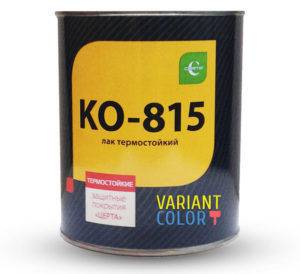
Heat-resistant varnish KO-815
KO 815 has the following properties:
- It does not lose its properties both at low temperatures (-60 ° C) and at high (+ 300 ° C). This quality allows you to apply varnish at any air temperature.
- With a coating thickness of 20 to 40 microns, the approximate varnish consumption is 110 g / m2.
- Rejection (transformation of a material from a liquid state into an infusible solid) after application is carried out by a hot method, most often using a thermo-radiation method (infrared rays).
- The hazard of the substance belongs to the 3rd (moderate) fire hazard class.
To obtain the maximum effect from the coating, it is recommended to apply several coats each, of which must dry for at least 1 hour. The final polymerization takes place after 72 hours. It is sold in containers from 5 to 50 kg.
Alternative to KO 85 and KO 815
You can replace the popular varnishes presented above with Siltek-1 paint. It also behaves well under the influence of high temperatures and it is not necessary to coat the artificial stone or metal structure with a primer before applying it.

Siltek-1 paint
Siltek-1 is applied to brickwork, which will subsequently be exposed to high temperatures, in 3 layers with an estimate of 300 g / m2 consumption. Subsequent coating is applied only after half an hour.
The processing of strongly heated elements of fireplaces (brick, metal) should be carried out only with heat-resistant varnishes or other special compounds, otherwise, there is a possibility of ignition, leading to a fire.
You should also adhere to the basic rules for applying a paint and varnish product to the surface (cleaning, degreasing, drying). This will help to extend the life of the coating and improve the aesthetic qualities of the artificial stone.
Production products
Modern manufacturers of paints and varnishes have not left the market of materials for fireplaces and stoves without their own attention. That is why everyone can purchase a varnish for stoves and fireplaces with suitable characteristics and parameters. The most popular today can be called KO 85, which is used to treat furnaces not only in private houses, but also in the industrial field.
It contains organosilicon resins mixed with a solvent. Its immense popularity is based on the following qualities:
• increased heat resistance (up to + 300 ° C);
• endurance, the ability to withstand large temperature changes (from - 40 C to + 300 C);
• does not exfoliate after a long period;
• well applied to any surface;
• possibility of application at negative temperatures.

Heat-resistant varnishes for stoves and fireplaces
No varnish can boast of such properties, therefore the 85th always finds application when it is necessary to process a stove or fireplace. But this is not the only representative of this product in this class. If you want to varnish the inner surface of the brick, which lined the firebox of a stove or fireplace, then manufacturers advise using varnish KO 815.
Despite the fact that the temperature limit of this varnish is slightly lower, by as much as 50 degrees compared to the 85th, it perfectly withstands the effects of open fire. This contributes to the high-quality processing of the inner surface of fireplaces and stoves, open to the public. A high-quality decorative coating will delight the eyes of the owners and their guests for a long time, and the combustion section itself will receive bonding qualities that it did not have before processing.

Heat-resistant enamels for painting stoves and fireplaces
It should be noted that both types of varnishes can be tinted with KO 174 paint, which makes the decorative finish of stoves and fireplaces much more diverse. The resulting mixture is suitable for metal and stone, as well as wood. This allows you to get an excellent interior element that is completely fireproof and as durable as possible.
Consumption of varnish KO 85 and KO 815 is absolutely the same. To cover the first layer, it will take up to 250 g / m2. The second will require 100 grams and the third will need 50.
If it is necessary to apply more than three layers, which is very rare, then the consumption will not exceed the third indicator. The fact is that the first layer closes all large and small pores in the material. The second closes the remnants of large depressions, and the third completes the creation of a high-quality and durable film.
Why varnish your oven?
Experienced experts recommend always applying a protective varnish to the brickwork. This is done not only for the purpose of beautiful design. After all, such a coating is resistant to high temperatures and reliably protects the heating device from mechanical and chemical damage.
Transparent heat-resistant varnish for a brick oven has the following advantages over other coatings:
- Resistant to high temperatures. Thanks to this characteristic, the varnish coating will last for a long time, despite the high temperature marks.
- Improves the resistance of bricks to abrasion. The coating on which such a product is applied will be protected from mechanical abrasion.
- Prevents washing out of the oven seams.
- Helps to strengthen the entire masonry.
- Increases moisture-repellent characteristics. Thanks to this, you can not be afraid that water or other liquid will damage the surface while using the oven.
- Provides resistance to aggressive substances. Heat-resistant varnish for brick ovens allows you to clean the oven surface from dust, dirt and stains using various detergents. You can be sure that the coating will not be damaged.
- Gives a special shine. Even the color of an ordinary brick is able to reveal itself in a new way, if it is covered with thermal varnish.
Examples of oven varnishing:

Photo 1
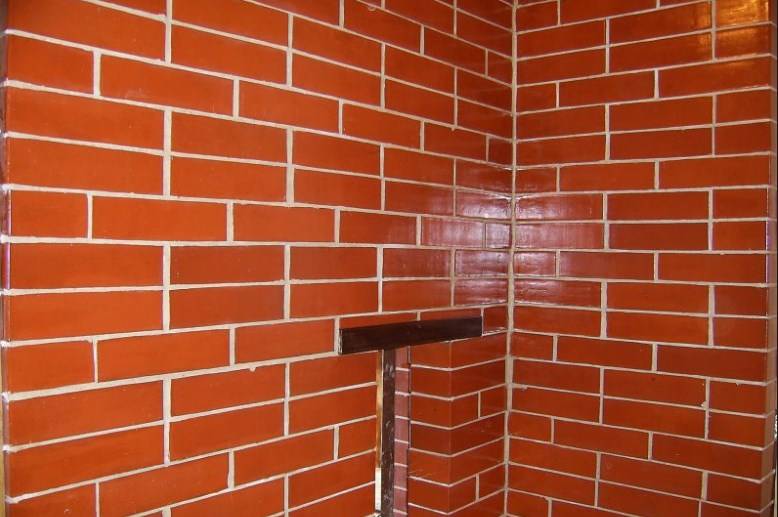
Photo 2
Interesting: Barrel Smokehouse: Important to Know
No. 2. What are the varnishes by composition
Brick varnish - a universal product for protecting brick base
But in order for the varnish to lie flat on the material and fully perform its functions, it is necessary to choose it correctly, paying attention to its composition
Polymer varnishes
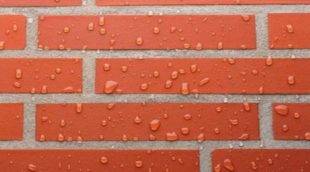
This is the most popular type of paintwork materials. The demand for this product is due to its versatility. It can be used on brick and concrete substrates. Polymer varnish can be applied at sub-zero temperatures and in rooms without heating. It is easy to apply, dries quickly and reliably protects the material from scratches, cracks, moisture and dust. The mixture can be used to protect interior and exterior walls. Due to the ease of application of the polymer composition, it can be used by both professional craftsmen and beginners. Polymer varnishes are affordable.
Silicone acrylic varnishes
This type of paintwork is suitable for interior walls. Silicone-acrylic mixture can be used to cover not only bricks, but also concrete, ceramic tiles, drywall, metal. The composition is often used for application to decorative items.
Due to the presence of special polymers in the mixture, the varnish can be of various shades. In addition to the protective layer, the wall treated with this compound can be transformed into any color, depending on your wishes.
Silicone-acrylic varnish protects the base from alkalis, acetone, oils. The only disadvantage of such mixtures is the price, which is much higher than polymer analogues.
Polyurethane varnishes
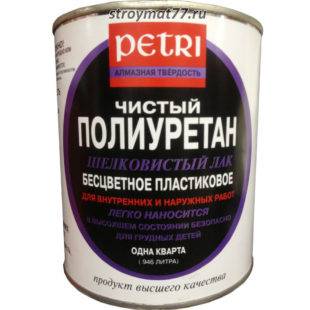
It is a versatile product that can be used to coat interior and exterior walls. It is the polyurethane varnishes that create the “wet” effect on the brick base. They have excellent moisture-repellent characteristics, which is why they are most often purchased for treating external walls.The popularity of polyurethane varnishes is also explained by the fact that they can be used to process not only brick, but also concrete bases.
Heat-resistant varnishes for fireplaces and stoves

This is a separate category of paintwork materials, which differ in the characteristics of heat resistance, fire resistance. They are designed to prevent condensation from forming on the walls of stoves and fireplaces. Due to their high moisture resistance, such paints and varnishes are also purchased for decorating and protecting building facades.
Solvent varnishes
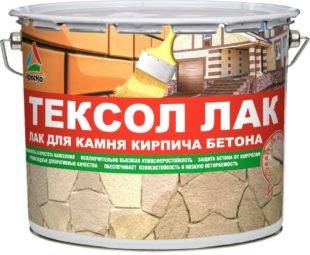
These formulations are based on silicone resin and solvents. When penetrated into the material, they create a strong protection, preventing cracking and discoloration
But, at the same time, such varnishes are easily flammable, and it is necessary to work with them extremely carefully, observing safety rules
Impregnations

In order to strengthen any paint and varnish, you can use special sealing impregnations. They are made on the basis of silicone and acrylic resins with the addition of aromatic, aliphatic solvents. Due to this composition, maximum protection of the paint and varnish for the brick base is provided. When using impregnation, deep penetration of paintwork materials into the building material is guaranteed.
In addition, sealants provide an extra layer of protection against seasonal rainfall, chemicals and UV rays. Many manufacturers also offer decorated options with a "wet stone" effect. The negative side of such impregnations is their use only for external or internal walls; they cannot be used in work with stove and fireplace installations.
Advantages and disadvantages
The properties of the varnish are such that the product can be used both indoors and outdoors. When applied, paintwork does not roll or deform. The varnish is used for any brick walls, including those located vertically, obliquely and horizontally. The large number of benefits has led to a growing interest in the product. The demand for paints and varnishes is growing steadily.
Untreated brick is constantly exposed to moisture. Over time, it loses its strength, gradually collapses. The outer walls suffer more from this "ailment". They are poured by streams of rain, hail beats, snow falls on them, dust and pollution stick. All year round, the facades are "attacked" by external forces. High-quality protection of the facade in the form of varnish treatment gives it the ability to repel water and resist the destruction of the entire structure.
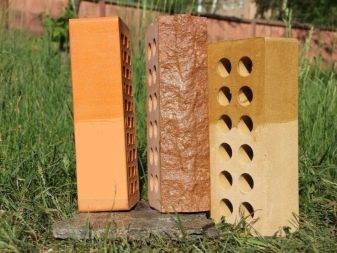

Lacquered masonry is protected from high temperatures. This ability is especially important for stoves and fireplaces. A brick or stone heating device becomes truly beautiful, even exquisite. In addition, it gains long-term fire protection.
The paintwork perfectly protects buildings from the appearance of white salt stains on brick walls, which can disfigure the masonry of houses and fences. Any stone surfaces are transformed after coating with brick varnish, they have a smoothness and shine. The special properties of paintwork materials do not allow dust to accumulate on the masonry.
If you take a varnish with a high gloss content, the walls take on a wet effect. A country house with such processing becomes like a fairytale tower. The use of "wet stone" indoors favorably distinguishes the masonry. Designers often use this method to focus attention on a specific element of the room. LKM on stone make facades more attractive, emphasize the richness of texture, speak of the wealth of the owners of the building.
The disadvantages include the presence of specific odors, as well as the need to work with the use of personal protective equipment for both skin and eyes and respiratory tract.

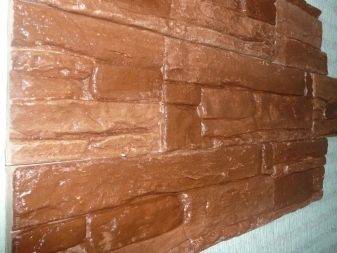
Application Algorithm
Before applying the heat-resistant varnish, time should be taken to prepare the surface. First, you need to remove dirt and dust with a brush, then get rid of oil and other similar stains with household chemicals.
The room where the work is carried out must have a temperature between + 18 ° and + 25 °.In addition, it is necessary to organize its ventilation as part of the preparation. It is also advisable to prime the surfaces of the fireplace or stove before varnishing. And only when the primer is dry, you can start varnishing.
You should carefully open the container and start stirring slowly. At the same stage, you can add heat-resistant paint of the desired color (heat-resistant varnishes themselves have a transparent structure). Thus, it is possible to combine varnishing and staining procedures.
Heat-resistant varnish can be applied to metal parts and masonry with a brush, roller or spray gun. In this case, you must try to prevent the occurrence of streaks and air bubbles.
When using a spray nozzle, the diameter of the nozzle should be 1.8-2.5 mm, and the distance from the spray nozzle to the surface to be processed should be from 20 to 30 cm.
After the first layer has dried, the heat-resistant compound can be reapplied to the surface of the fireplace or stove. Usually, two or three coats are sufficient.
